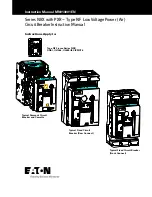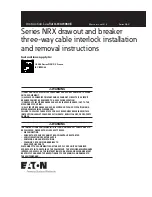
NF50 AND NF100 CIRCUIT BREAKER QUICK START MANUAL
3
1. SAFETY PRECAUTIONS
Carefully read the safety precautions prior to use the circuit breaker
correctly. Important safety instructions are given below. Strictly observe
the instructions. Be sure to communicate these safety precautions to
the end user.
Please note that the specifications for the products in this manual are
subject to change without prior notice. The products in this manual are
designed and manufactured as general-purpose products for general
industrial uses. If you intend to use them for a special purpose, such
as nuclear power, electric power, aerospace, medical or passenger
vehicle equipment or systems, please contact Mitsubishi Electric at
[email protected].
We are not responsible for compensation for damage caused by
any reason not attributable to us, opportunity loss or lost earnings
of customer caused by trouble of our product, damage, secondary
damage, accidents or damage to any product other than our product
caused by special circumstances or any other operation. The safety
precautions are ranked as “DANGER” and “CAUTION” in this manual.
DANGER
Indicates that incorrect handling may cause
hazardous conditions, resulting in severe injury or even death.
CAUTION
Indicates that incorrect handling may cause
hazardous conditions, resulting in personal injury or physical
damage.
Depending on the circumstances, procedures indicated by
CAUTION
may also cause severe injury. It is important to follow all precautions for
personal safety.
DANGER
Do not touch the terminal area. Doing so can cause an electric shock.
The earth leakage circuit breakers are designed to operate when the
difference between leaving current and returning current exceeds the
specified value. In some cases the earth leakage may not be detected.
Therefore, never touch the two bare live parts. The circuit breaker will
not operate upon occurrence of an electric shock.
CAUTION
Instructions for installation
• The electrical work shall be performed by qualified personnel
(electricians).
• Before performing wiring work, turn off the upstream circuit breaker,
and ensure that no current is flowing through the circuit breaker to
be wired. Failure to do so may expose you to shock hazard.
• When connecting any wire, tighten the terminal screw to the torque
specified in the instruction manual. Failure to do so may cause a fire.
• When the model comes with insulating barriers as standard
accessories, install the insulating barriers without fail.
• Do not install the circuit breaker in an abnormal environment with
high temperature, high moisture, dust, corrosive gas, vibration
or shock. Doing so may cause a fire or make the circuit breaker
inoperative.
• Protect the circuit breaker so that foreign particles, such as dust,
concrete powder and iron powder, and rain water will not enter
the circuit breaker. Failure to do so may make the circuit breaker
inoperative.
• Connect the circuit breaker to a power supply appropriate to the
rating of its body. Failure to do so may make the circuit breaker
inoperative or damage it.
• Tighten securely the lead wire in the open phase to the neutral wire
on the load side. If the wires are not connected, the open phase of
the neutral wire cannot be detected.
• When there are two terminal screws for the neutral pole, tighten the
screws alternately. Failure to do so may loosen the screws, thereby
causing a fire.
CAUTION
Instructions for use
• When the circuit breaker automatically breaks a circuit, turn on the
handle after removing the cause. Failure to do so may cause an
electric shock or a fire.
CAUTION
Instructions for maintenance
• The circuit breakers shall be maintained by persons with specialized
knowledge.
• Before maintaining, turn off the upstream circuit breaker, and
ensure that no current is flowing through the circuit breaker to be
maintained. Failure to do so may expose you to shock hazard.
• Retighten the terminals periodically. Failure to do so may cause a
fire.
CAUTION
Instructions for disposal
• When disposing of the product, treat it as industrial waste.
1.1 STORAGE AND TRANSPORTATION
n
PRECAUTIONS FOR STORAGE
•
Avoid corrosive gases. Do not store the product in an atmosphere
containing acidic gas or ammonia gas. H
2
S: 0.01ppm or less; SO
2
:
0.05ppm or less; NH
3
: 0.25ppm or less.
•
Breaker storage. Store the breaker in the OFF state or tripped state.
•
Avoid moisture. Do not leave the breaker in a humid place for long
periods of time.
•
Carefully pack and transport. Do not drop the package during
transportation. When shipping the breaker, make sure to package it
carefully.
•
Do not carry by holding the front and back of the flush plate. Do
not carry the embedded type breaker by holding the front and back
of the flush plate. The breaker could drop during transportation.
• D
o not carry by the lead wires. Do not carry the accessories by
the lead wires. Excessive force will be applied on the accessories.
•
Do not transport upside down (when mounted on IEC 35mm
rail). Do not transport a panel containing parts mounted on an IEC
35mm rail in an upside down state.
1.2 STANDARD WORKING CONDITIONS
Working ambient temperature: -10°C to 40°C. (Note that the 24-hour
average value must not exceed 35°C) working current reduction rate in
ambient temperature exceeding 40°C.
50°C… 0.9 fold
60°C… 0.7 fold
• Relative humidity: 85% or less with no dew condensation.
• Altitude: 2000m or less
• Atmosphere: Free of excessive moisture, oil vapors, smoke, dust,
salt, corrosive substances, vibration or impact, etc.
1.3 MOUNTING AND CONNECTIONS
n
PRECAUTIONS FOR MOUNTING
•
Attention to dust and cutting chips. Make sure that the breaker
does not come in contact with rain water, oil, dust or cutting chips.
Special attention must be taken to conductive materials such as
scraps from drilling steel plates.
Mitsubishi Electric Automation, Inc.





















